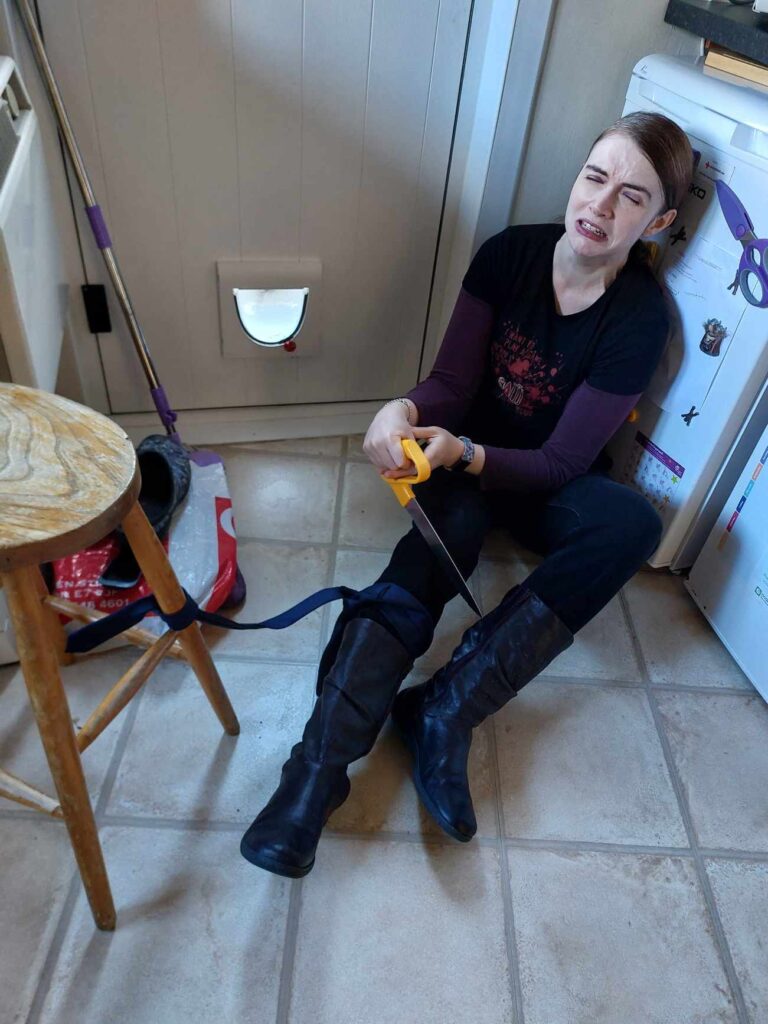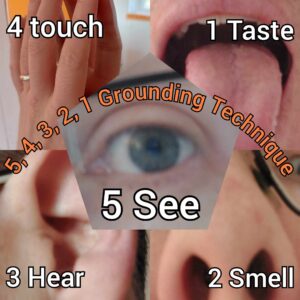Note: This article is satirical, and you will likely guess how I might conclude, but researching this for Halloween did uncover some interesting topics such as physical punishment, sudden change, and growing from trauma.
The Saw Franchise
My wife and I just finished a “Saw” Marathon of the ten films, then did the Escape Experience to finish. As a counsellor, I regularly see people finding sudden changes within therapy that adapt their personality for the better, and it got me wondering: Would the Philosophy of John Kramer (Jigsaw) and the Saw traps help a person to change their lives for the better?
If you’ve not seen a “Saw” Movie, they are gory horror movies in which a person is locked in a trap and forced to graphically mutilate themselves in order to survive. That person usually has a long criminal history, some kind of character deficiency, or is immoral and unethical in their work or actions. For example, the film ‘Spiral’, which is set in the SAW universe, features a corrupt cop who repeatedly lies in the witness stand. Part of Kramer’s philosophy isn’t that the person is being punished, but rather ‘tested’ or ‘playing a game’ (usually with a short time limit). In this ‘game’ the person is trapped, and they must make a choice to mutilate the body part which is contributing to their immoral dealings to escape. In this example, this lying cop is hung by his tongue on a train track and needs to rip it off in time to escape the oncoming train. There are various survivors of these traps across the Saw films , and in Saw 7 there’s even groups (like you see in 12 Step Programs) for people who have survived and found some kind of purpose or transformation from these ‘Games’. Some of those survivors go on to want to replicate Kramer’s techniques, becoming protagonists for future movies, but usually their old behaviour prevents them from fully adapting Kramer’s philosophy without personal gain or vengeance.
Personality Change
Carl Rogers is the founding father of Person-Centred Counselling, and in 1957 writes about therapeutic personality change (Rogers, 1967). He talks of Moments of Movement in therapy, and those moments spilling out of the connection between the therapist and the client, where the client feels fully received for every aspect of themselves and deeply and empathically understood. In my experience, sometimes these moments can be rapid and sudden for clients, and other times there are gradual ‘aha’ moments that emerge over many sessions. Rogers typifies personality change as beginning from a place of rigidity, based on the past and previously absorbed ideas, detached from our experience, and various contradictions within us. The relationship can then move us to a place of flow where feelings, experiences, and individual meanings continually emerge and bubble up in a state of continual change. Rogers (1951) adds that as our personality changes within an environment of genuine acceptance and empathy, we become more understanding and accepting of others as unique individuals (just as we become more accepting of ourselves), which results in the building of community and away from hate. This environment is obviously very different to the environment Kramer is trying to create where we must choose to violently remove a body part that we are misusing, so could Kramer’s technique actually help a person?

AA, Psychedelics, and Sudden Change
Bill Wilson, co-founder of Alcoholics Anonymous (AA), was infamously quite intrigued by the potential for using LSD to bring about transformation in people who are stuck in the midst of alcohol addiction after Bill’s own experiences of being treated with the psychedelic drug. The reason for this was seeing the potential of LSD to create a “Spiritual Awakening”, helping them to look beyond their own lives to something more powerful. If we look at Steps 1 to 3 of the Twelve Step Program, they require a person to firstly recognise that they are powerless over their addiction, then to believe in a power greater than themselves that can restore them to sanity (sobriety), which they then give themselves over to. Bill Wilson felt that LSD could provide that ‘Damascus Road’ experience of being so impacted by an experience that their lives are changed into believing in that ‘Higher Power’
Note that in Appendix 2 of the Big Book, Herbert Spencer talks about how, for many people in the fellowship, this transformation will not be dramatic and sudden, but discovered gradually.
Applied to those groups in Saw 7, the survivors talk about being impacted by this event and inspired to live their lives anew, as though the physical and psychological trauma of what they went through has somehow inspired them to see a new way of living, and powerfully enabled them to step out of their pasts through their own violent ‘Spiritual Awakening’. It does, then, seem possible that these barbaric traps could be a turning point in the victim’s life in the same way that a psychedelic drug might provide a new perspective on our lives. Some differences being that the person has not chosen to be in a trap (unlike taking a psychedelic willingly/recreationally?), and the trauma of it does not necessarily mean the person is able to see the world from a new perspective to have that spiritual awakening. In the case of LSD, Wilson’s hope was seeing the potential for a Higher Power, whereas in Saw there is no Higher Power or Big Book of the Kramer method.
Rock Bottom
In 2008 Groundswell UK published a research project called The Escape Plan for people experiencing homelessness to research what has enabled people to move on from it. To do this, they interviewed twenty-five people who had ‘escaped’ homelessness (“escapees”). They identified seven key factors in ‘escaping’ homelessness and one of those was reaching “rock bottom” – an epiphany that 10 of the 25 participants identified with. In reaching Rock Bottom, they realised they could not continue the path they were on, and change was needed in their lives to live a more desirable future. One participant wrote: “So, It’s either you sort it out, like, you say you can or, you just piss off and die somewhere, because at the end of the day… either it’s put up or shut up” (Groundswell, 2008. Pp32).
Applied to Saw, we need to realise a few things. The first is that each escapee’s Rock Bottom is individual to them (e.g. for one person, losing a leg to a DVT may be a strong motivator for change, whereas for another it may not be enough). It’s true that each trap is custom made for the individual, but with rock bottom being so subjective there could be no way of forcing that experience. The second is that the escapees talk about the importance of making a choice after realising their lives are out of control because of reaching rock bottom. In the Saw traps, the victims seldom, if ever, have a strong sense of guilt that their actions have had consequence – an emotional rock bottom. The victims have also not chosen to be in those traps, nor is it a direct consequence of their behaviour – they have not decided to change, rather they are being punished (‘tested’) and forced to change. Finally, escapees mentioned the need for support to be around them when they reach rock bottom and are trying to make a choice to change e.g. recovery workers for addiction; in Saw the victim is usually left mutilated and alone rather than supported by a program to encourage reflection on change and the numerous practical and psychological steps we need in order to reach it.
Violence and Discipline
In Saw V, Jigsaw says “you and I both know the statistics for repeat offenders in this city. 67.5% of criminals are back in prison within three years”. What he is saying is that a custodial sentence doesn’t rehabilitate a person compared to the Saw method. Government UK Statistics for 2021, put overall proven re-offending rates at 24.3% but it opens the question on if punishment works? A 2002 meta-analysis of 442,000 offenders in Canada looked at if punitive approaches to offending such as incarceration or boot camps worked. It found that harsher punishments did not reduce reoffending, in fact punishment increased reoffending by 3% – especially if that punishment was a long custodial sentence. What this is saying is that getting ‘tough on crime’ to punish offenders does not work, and so a trap that punishes someone would not work.

A review in 2021 on twenty years of seeing the effects of smacking found that rather than improving a child’s behaviour, smacking makes it worse in the long term. Rather than violence teaching a child their wrong doings, they learn to accept violence and anti-social behaviour as normal. Rather than the safe, accepting, empathic environment I described for fostering personality change, violence as a means of discipline can destroy a sense of safety into a home as a dangerous place. In reviewing the research, Durrant and Ensom highlight how corporeal punishment in children can lead to aggression, anti-social behaviour, mental health issues, addiction, less cognitive development, and the punisher is likely to go too far and injure the child. Applied to Saw, people like Amanda or Detective Hoffman, who experience a spiritual awakening from their Saw traps, end up being ‘converted’ and putting other people in those traps. Could it be argued, that just like a child subjected to corporeal punishment, Hoffman and Amanda are converted into subjecting the violence they experienced onto others whilst being desensitised to the tortuous gore they inflict? What is clear is that violence is not an evidence-based means of rehabilitation, and that any change is likely to be short-term or more motivated by fear than an internal personality change. Furthermore, punishment is not an evidence-based method of rehabilitation.
Medieval Torture & Consequential Thinking
I tried to find statistics on the efficacy of medieval torture, or violent means of torture to rehabilitate offenders and, unsurprisingly, could not find any. What stood out for me in trying to find statistics, however, is that torture and corporeal punishment are not meant to rehabilitate. Rather, the medieval tortures were often used to try to extract reliable information (which it also isn’t very effective at) or to warn others of the consequences of breaking laws. The problem with trying to scare people into behaving because of consequences, however, is that when someone commits a crime, they usually aren’t thinking consequentially about the punishment – just as when we smoke a cigarette, we aren’t mulling over the health impacts on our body. During my working week I facilitate groups for people in recovery from addiction, and one powerful technique when we experience cravings that might lead to lapse is to Play the Tape Through to the End. The person might be craving a drink and there could be euphoric recall of how nice it might taste, or fun times down the pub with friends. Rather than settling on that urge or craving, Playing the Tape Through considers the consequences fully of relapse – the allergy-like reaction of not being able to stop drinking, having to lie to loved ones, committing crime to fund the habit, the impact on health, the depressive feelings and self-loathing. This is the power of full consequential thinking to rehabilitate, but this is a technique usually taught to people who are abstinent – not during active-addiction. Violence and Medieval torture aren’t great deterrents for offending because the person offending is unlikely to consider the consequences of their actions in the moment of their offence. What I’m arguing, in relation to Saw, is that knowing the Jigsaw Killer is active in a city is unlikely to have much of an effect on offending and that scaring a person into rehabilitation by torturing them doesn’t suddenly give them consequential thinking for the future. The only effect I can imagine is that being maimed might make it harder to reoffend e.g. the lying cop would struggle to lie if they had their tongue removed.

Post-Traumatic Growth
Trauma is a human response to a profoundly shocking incident or prolonged exposure to incidents that we struggle to process and stays with us intrusively in our mind and body. For example, five years ago I did CPR on someone who had died and experienced disturbing visceral flashbacks of doing this; it took a long time to process, and still, at times, has the power to shake me. Trauma responses to situations and what causes a trauma response can be personal (e.g., an ambulance worker is likely to do a similar thing regularly without trauma reactions), but it feels fair to say that being in one of the Saw Traps would constitute a traumatic incident for most people – gore, pain, loss, and the narrow escape from death. Joseph & Murphy (Pearce & Sommerbeck, 2014) write about trauma as completely disorganising the self-structure due to the threat of this new trauma related information, and with our understanding of self being so shattered, the trauma memory haunts us intrusively with strong feelings attached. However, they write about how therapeutic conditions of acceptance and understanding can stimulate the person to grow in their own way to not just process their traumas but experience post-traumatic growth as that trauma information is integrated into the self-structure. Trauma is deeply disturbing, and as a counsellor it is a privilege to see people processing their trauma and gaining insights that can be protective and add meaning to their lives. Although we can grow from our traumas, for example reassessing our life after a bereavement or near-death experience, and develop as people, we don’t endure traumatic events deliberately to grow, nor could the post-traumatic growth be predicted. In conclusion, a person may grow from being in a Saw Trap, but inflicting traumatic incidents on a person isn’t a way to initiate growth, and even if there was some kind of personal growth it would be difficult to predict.
Compassion for Those Needing Rehabilitation
In his 19 Propositions, Carl Rogers says that we are all unique human beings and if we could truly understand each other and our upbringings, then the way we behave would make sense as an attempt to meet our needs. Sometimes those attempts to meet our needs can seem a little bizarre (even to us), maladaptive, or even antisocial; but if we can truly listen to that behaviour as trying our best with what we have, it can make sense, and in making sense, change can be an option. No-one wakes up one day and says I’d like to be addicted to heroin, or I’d like to be a criminal. Instead, we need to recognise that rates of mental ill-health, traumatic experiences, abuse, unmet needs, undiagnosed neurodiversity, being in a minority group, lack of educational and support opportunities, and neglect disproportionately affect people with an offending background or those with addiction issues. No wonder punishment alone doesn’t rehabilitate – the people being punished in these Saw Traps have already been punished a lot by life. Kramer’s philosophy is that everyone gets a choice and a chance to escape their old lives, and there is a future for them – it just doesn’t acknowledge the weight of their pasts and puts the blame on the individual to change rather than a compassionate understanding of why their lives may be the way they are.
UK Government Aims for Rehabilitation vs Norway’s
The 2021 Prison Strategy White Paper sets out some plans to reduce reoffending in the UK. Those were to make prisons clean from drugs and prisoners treated for addiction, education, helping offenders move towards employment, support before they are discharged, and punishments if there is anti-social behaviour during their sentence. To me, support around addiction and towards employment and meaningful uses of time feel like a good direction for us to aim. Norway has an approach to prisons and rehabilitation, where the main emphasis is away from punishment and incarceration towards rehabilitation. Consequently, prisons in Norway have good facilities; as well as access to work, training, and counselling. Furthermore, the culture of the nation wants criminals to be rehabilitated, and able to reintegrate and contribute back to society.

Conclusions and other Considerations
John Kramer, and his imperfect disciples in future movies, recognise that rehabilitation is unique to the individual and a one-size-fits-all approach doesn’t work. However, unlike Norway or modern restorative justice approaches, they decide trapping people into a unique machine and forcing themselves to chop off body parts is the best motivator for change. In researching punishment, we have discovered that it doesn’t work and violence as a means of punishment only leads to more anti-social behaviour. The violent gory punishment might traumatise a person, and in processing that they may grow, but we don’t traumatise a person to grow. We learnt that change could come suddenly from spiritual awakenings, or from hitting rock bottom, but those things cannot be forced on a person and that having to pull off your fingers is unlikely to be that vehicle for spiritual awakening. Finally, we learnt that the conditions that bring about change therapeutically are usually ones of empathy and value to the individual, and when applied to a prison can look like investing in the individual and their future.
In conclusion, Kramer wanted to do more for individuals to help them change, but all he really managed was to cut off a few limbs and kill people who couldn’t subject themselves to that torture within the time limit. He could ask people if they want to ‘play a game’, then wait for their consent. He could, instead of violence, help people with their recovery or qualifications until they reach that ‘aha’ moment themselves. He could arrange meetings with people whom they have hurt and facilitate restorative justice. Unsurprisingly, my conclusion is that Kramer’s philosophy does not work, and should not be taken up as a form of rehabilitation. But this wasn’t only obvious from the beginning – the films themselves demonstrate how his ideas don’t work out in practice with even those who are ‘rehabilitated’ not being able to change. Although this article is satirical, could we learn something when people wrong us – could we approach them with understanding, and realise when we punish those around us it’s unlikely to really change them for the better?
References
Rogers, C.R. (1951). Client Centred Therapy. Constable and Company LTD (reprinted 1986).
Chapter 11: A Theory of Personality and Behaviour. Pp 481 – 533.
Rogers, C.R. (1967). On Becoming a Person: a Therapist’s View of Psychotherapy. Reprinted in 2016 by Robinson Publishers.
Chapter 7: A Process Conception of Psychotherapy. Pp125 – 59.
Pearce, P; Sommerbeck, L. (2014). Person Centred Practice at the Difficult Edge. PCCS Books.
Chapter 1. Murphy, D & Joseph, S. Understanding Posttraumatic Stress and Facilitating Posttraumatic Growth.
Simon is a Person-Centred Counsellor in Oxford working remotely and in person. He endures horror films with his wife, and appreciates the opportunity for reflection. He believes in the potential of each individual for growth and change, and thankfully we dont have to chop of our tongues to get there







